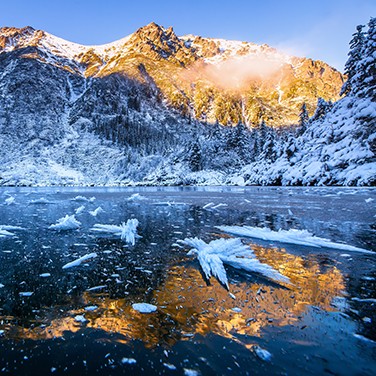How Warmer Winters Are Disrupting the Water Cycle
By Kylie Wolfe
Imagine snow-capped mountains, crystal-clear waters, and light flurries falling from the sky. A setting like this is more than just a great photo op. Many western states, even those without this picturesque scene, rely on snowfall as their main source of water.
According to the United States Geological Survey, melted snow accounts for nearly 75 percent of the water used in the western states. During certain times of the year, melted snow is the sole source of streamflow, meaning snowfall totals during the winter can impact water resources throughout the year.
Snow Science
At first glance, the water cycle seems simple: precipitation, collection, evaporation, condensation, repeat. Even in the mountains, where snow collects from October to April, it’s easy to imagine snow melting and flowing downhill from April to June. And while that’s true, the process is much more complex.
Before winter sets in, moisture accumulates in the soil. This determines the amount of water it can absorb and ultimately the runoff produced in later seasons. Dry soil will absorb more melted snow and vice versa.
When winter hits and snowflakes stack on top of each other, they crush the crystalline structures of those underneath. This increases the density of the snowpack, an accumulation of snowfall that’s been compressed by its own weight.
The snow will begin to melt when the temperature of the snowpack equalizes at 32°F. As it melts, some will sink into the soil and some will travel downhill. The water that contributes to soil moisture can be used by plants, flow into a stream, or evaporate. Much of it is diverted into reservoirs for later use.
Knowing the snow’s density, or mass per unit volume, can help determine how much water it will yield. In some areas, like the west side of the Cascade Range, one foot of heavy, wet snow can yield up to an inch and a half of water. In other areas, like the Wasatch Mountains of Utah, a light and powdery snow can yield an inch.
The amount of water, or snowmelt, that results from a winter’s snowfall also depends on variables like precipitation patterns, air temperature, and frequency of storms.
A Changing Climate
Scientists are noticing that less snowpack is accumulating and warmer temperatures are causing it to melt earlier. In addition, more precipitation is falling as rain than snow. This is known as snow drought. At first mention, it may not sound like a problem, but it means the mountains have no way of storing water for future use. And as the ground becomes oversaturated, excess water has nowhere to go but down. This can lead to flooding and wasted resources.
In addition, higher temperatures are resulting in fewer freeze-thaw cycles during the winter months. This means less moisture is able to sink deep in the ground where it’s less likely to evaporate.
While too much snow or rain can cause flooding, too little snow can cause water shortages. It’s a delicate balance. But because of climate change, snowpacks aren’t as reliable of a water source as they once were.
Without a consistent source, people in many western states could experience water shortages. The Colorado River alone reaches seven U.S. states and Mexico. This can impact the amount of water available for drinking as well as irrigating valuable crops.
Predicting and Planning
Snow-covered mountains aren’t just a beautiful back drop for your next selfie. They’re natural water towers that play a vital role in maintaining a sufficient water supply, even in places where it never snows.
Hydrologists and forecasters are teaming up to measure water content and predict the amount of runoff each season. They’re hoping to plan for potential droughts and floods, protecting existing water supplies and encouraging water conservation.
